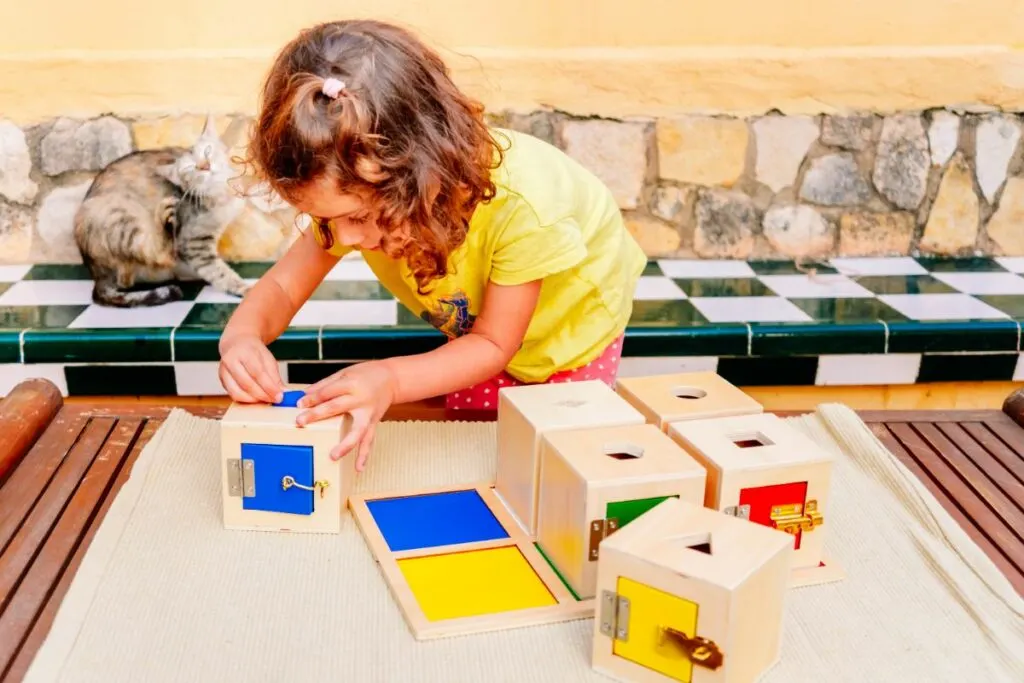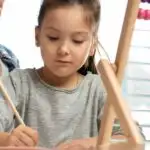Exploring the concept of homeschooling often leads parents to consider various educational philosophies, one of which is the Montessori method.
This method, developed over a century ago by Dr. Maria Montessori, offers a unique approach to learning that has been embraced by educators worldwide, including homeschooling families.

In this guide, I’ll provide an insightful look into Montessori homeschooling, outlining its principles and how to implement the teaching strategies at home.
What Is The Montessori Method Of Homeschooling?
The Montessori method of homeschooling is a child-centered educational approach developed by Dr. Maria Montessori.
Its core principle is respecting the child’s natural psychological, physical, and social development.
Unlike traditional education systems, the Montessori approach emphasizes hands-on, experiential learning and collaborative play – a key part!
It encourages self-directed activity, allowing children to make creative choices in their learning process, with the teacher offering age-appropriate activities to guide the process.
Key components of the Montessori method include mixed-age groupings, a focus on the whole child, an emphasis on developing independence, and a prepared environment.
This environment is meticulously organized and equipped with materials that meet the developmental needs and interests of children at different stages.
In a homeschool setting, this translates to creating a learning space at home that stimulates and nurtures the child’s innate curiosity and love for learning.
The Benefits Of Montessori Homeschooling
Now we know a little more about what Montessori is, let’s take a look at the benefits of this type of homeschooling.
Montessori homeschooling offers a unique and enriching approach to education, presenting several benefits that cater to the holistic development of children.
Tailored To Each Child
One of the primary advantages is the emphasis on individualized learning.
Unlike traditional education systems that often follow a one-size-fits-all curriculum, Montessori homeschooling is tailored to the child’s specific learning pace, interests, and abilities.
This individualized approach allows children to explore subjects that intrigue them deeply, promoting a more profound and meaningful learning experience.
Independent Learning Skills
Another benefit is the development of independent learning skills. The Montessori method encourages children to take charge of their learning journey.
By providing an environment where children can choose their activities and work on tasks with minimal adult intervention, Montessori homeschooling cultivates self-discipline, problem-solving skills, and a love for learning.
This independence in learning not only fosters academic growth but also builds life skills that are invaluable in the child’s future endeavors.
Hands-on Learning
The hands-on learning experience is a cornerstone of the Montessori philosophy.
Through tactile and interactive materials, children gain a concrete understanding of abstract concepts, especially in areas like mathematics and science.
This hands-on approach makes learning more engaging and effective, as it appeals to various learning styles and helps retain information better.
Social And Emotional Development
Montessori homeschooling also promotes social and emotional development.
Although a homeschooling environment might seem isolating, many Montessori activities are designed to encourage collaboration and social interaction.
This can be achieved through group projects, community activities, or cooperative learning setups with other homeschooling families.
Additionally, the emphasis on respect, community, and understanding others’ perspectives helps develop empathy and social awareness.
Flexibility
Finally, Montessori homeschooling offers flexibility often unmatched in traditional schooling settings.
It allows families to structure learning around their schedules and lifestyles, making education a seamless part of daily life rather than a separate, rigid activity.
This flexibility is particularly beneficial for families who travel, have unique lifestyle needs, or prefer a more integrated approach to education and life.
Advice On How To Start A Montessori Homeschool
If, after reading the benefits of this teaching method, you’re ready to apply this at home, I’ve included some advice below on starting your own Montessori homeschool program for your children.
Here are my recommended steps to get you started:
- Understand the Montessori Philosophy: Before implementing this method, it’s crucial to familiarize yourself with Montessori principles. This can be done through reading Dr. Montessori’s books, attending workshops, or joining Montessori parenting groups.
- Create a Prepared Environment: Design a learning space at home that aligns with Montessori principles. This space should be orderly, child-sized, and filled with materials that encourage exploration and learning.
- Select Appropriate Materials: Choose materials that are age-appropriate and cater to your child’s interests and developmental stage. Montessori materials are designed to be self-correcting and to facilitate independent learning.
- Plan a Routine: Establish a consistent daily routine that allows ample time for both structured activities and free play. Flexibility is key in accommodating your child’s natural rhythms and interests.
- Incorporate Practical Life Skills: Daily life activities are integral to Montessori education. Include tasks like cooking, cleaning, and gardening as part of the learning process.
- Observe and Guide: In Montessori education, the parent’s role is to observe and guide rather than direct. This involves stepping back to allow the child to learn independently, intervening only when necessary to support their learning.

Creating A Montessori Homeschooling Curriculum
Developing a Montessori homeschooling curriculum involves considering the holistic development of your child.
The curriculum spans various areas, including practical life, sensory activities, mathematics, language, and cultural studies.
- Practical Life: These activities focus on developing life skills and independence. They include tasks like dressing, cooking, and gardening.
- Sensory Activities: These exercises help refine the senses and develop cognitive skills. They involve materials that differentiate by size, shape, color, texture, sound, and weight.
- Mathematics: Montessori math materials are designed to make abstract concepts concrete, allowing children to understand and enjoy mathematics. Activities often involve physical objects for counting and calculating.
- Language: Language development in Montessori includes reading, writing, and vocabulary enrichment. Materials like sandpaper letters and movable alphabets aid in learning.
- Cultural Studies: This encompasses geography, science, history, art, and music, encouraging children to explore and appreciate the world around them.
Exploring The Montessori Curriculum In More Depth
Let’s take a look at some of these learning areas in more depth to really understand them:
Language Development
In a Montessori homeschool, language development is prioritized, starting from the earliest stages of education.
The Montessori approach to language is multi-faceted, focusing on phonetics, vocabulary building, and eventually, grammar and syntax.
Materials like sandpaper letters and movable alphabets are not just tools for reading and writing but are also designed to engage the child’s senses, particularly touch and sight, to reinforce learning.
Mathematics
Mathematics in Montessori is taught using a hands-on approach.
Children are introduced to concepts like counting, place value, and arithmetic operations through tangible materials like beads and blocks.
These materials help children visualize and understand mathematical concepts, making abstract ideas more concrete and accessible.
Cultural Studies
Cultural studies in Montessori encompass a broad range of subjects, including geography, history, science, art, and music.
These areas encourage children to explore their world, understand different cultures, and develop a sense of time and place.
Activities might include working with maps, learning about historical events, conducting simple science experiments, or exploring various forms of art and music.
Implementing Montessori Principles At Home
Implementing the Montessori method at home involves more than just academic learning.
It’s about creating an environment that respects your child’s natural development and fosters independence, curiosity, and a love for learning.
Here are my top tips:
Create A Prepared Environment
The home environment plays a crucial role in Montessori education. It should be structured and organized yet inviting and conducive to exploration.
This means creating specific areas for different activities, making materials accessible to children, and ensuring that the environment is safe and child-friendly.
Follow The Child’s Interests
Montessori education emphasizes following the child’s interests. Observing your child and understanding their current fascinations and developmental needs is crucial.
This observation guides you in preparing the environment and selecting activities that resonate with your child’s interests and abilities.
Encourage Independence
A core principle of Montessori is encouraging independence.
This involves allowing children to engage in tasks by themselves, make choices about their learning, and participate in daily life activities.
It’s about trusting the child’s ability and providing them with opportunities to develop self-reliance.
Challenges And Solutions In Montessori Homeschooling
While Montessori homeschooling offers many benefits, it also comes with its unique set of challenges. Here are some common challenges and solutions:
Balancing Structure And Freedom
Finding the right balance between providing structure and allowing freedom can be challenging.
It’s important to set clear boundaries and establish routines while being flexible and responsive to the child’s needs and interests.
Material Costs
Montessori materials can be expensive. However, many resources are available for making DIY Montessori materials at home.
Additionally, everyday household items can often be repurposed for educational use.
Time And Commitment
Implementing a Montessori homeschool requires significant time and commitment from parents.
It’s important to be realistic about what can be achieved and to seek support from the Montessori community, both locally and online.
Final Thoughts
Montessori homeschooling is an enriching approach that can provide a comprehensive and fulfilling educational experience for children.
By embracing its principles and adapting them to the home environment, parents can offer their children a unique and tailored educational journey.
As with any homeschooling approach, the key is to remain flexible, responsive to the child’s needs, and open to the learning journey that unfolds.
Further reading: What is independent homeschooling?
- Homeschooling In High School: Pros And Cons - February 24, 2024
- How Do I Withdraw My Child From School To Homeschool? - February 23, 2024
- How To Not Go Crazy Homeschooling Kids: A Guide For Frazzled Parents - February 22, 2024









Leave a comment